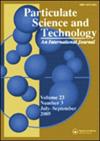跳汰过程中进料粒度偏析对能量消耗的影响:CFD-DEM研究
IF 1.5
4区 工程技术
Q3 ENGINEERING, CHEMICAL
引用次数: 0
摘要
摘要:跳汰机采用基于粒度的进料偏析来提高重选效率。由于进料中颗粒的大小和密度的变化,选择如何在跳汰前将其分离仍然是一个挑战。本文将尺寸范围为3 ~ 8mm的进给分离成不同的状态,然后采用计算流体力学的双向耦合方法和三维离散元法对跳汰性能进行了模拟。在不同状态下,对重力浓缩所需的能耗和循环次数进行了定性比较。仿真结果表明,将跳汰机进给分离为3 ~ 4 mm和5 ~ 8 mm两种尺寸可降低能耗和循环次数。因此,在细晶部分尺寸范围小,粗晶部分尺寸范围大的偏析状态下,能量消耗和循环次数最低。关键词:进料分选重力浓度双向CFD-DEM耦合跳汰能耗感谢卡山大学中央复杂实验室超快处理与计算中心披露声明作者未报告潜在的利益冲突。本文章由计算机程序翻译,如有差异,请以英文原文为准。
Effect of feed-size segregation on energy consumption during jigging: A CFD-DEM study
AbstractSegregation of feed based on size is used to increase the efficiency of gravity concentration by jig devices. Due to the variety of size and density of the particles in the feed, choosing how to segregate it before jigging is still a challenge. This article segregates the feed (with a size range of 3 to 8 mm) into the different states and then, simulates the jigging performance with the two-way coupling method of computational fluid dynamics and the discrete element method in 3 dimensions. In different states, the energy consumption and the number of cycles required for gravity concentration were compared, qualitatively. The simulation shows that the segregation of the jig feed into two size classes (3 to 4) and (5 to 8) mm decreases the energy consumption and the number of cycles. Therefore, the segregation state where the fine-grained part has a close size range and the coarse-grained part has a wide size range will have the lowest energy consumption and the number of cycles.Keywords: Feed segregationgravity concentrationtwo-way CFD-DEM couplingjiggingenergy consumption AcknowledgementThe authors are grateful to Central Complex Laboratory University of Kashan, Ultrafast Processing and Computing Center.Disclosure statementNo potential conflict of interest was reported by the author(s).
求助全文
通过发布文献求助,成功后即可免费获取论文全文。
去求助
来源期刊

Particulate Science and Technology
工程技术-工程:化工
CiteScore
4.40
自引率
4.00%
发文量
86
审稿时长
12 months
期刊介绍:
Particulate Science and Technology, an interdisciplinary journal, publishes papers on both fundamental and applied science and technology related to particles and particle systems in size scales from nanometers to millimeters. The journal''s primary focus is to report emerging technologies and advances in different fields of engineering, energy, biomaterials, and pharmaceutical science involving particles, and to bring institutional researchers closer to professionals in industries.
Particulate Science and Technology invites articles reporting original contributions and review papers, in particular critical reviews, that are relevant and timely to the emerging and growing fields of particle and powder technology.
 求助内容:
求助内容: 应助结果提醒方式:
应助结果提醒方式:


